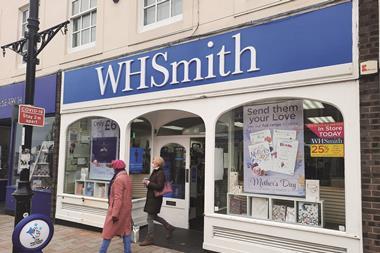Gianni Ciserani, VP and general manager of Procter & Gamble, UK and Ireland, tells Liz Hamson why P&G is building strategic partnerships with retailers
Inevitably, much of the focus is on brand extension, he admits. “The reason we need to focus on existing brands is because we need to make NPD feasible. We need to create critical mass round the brand.”
He’s still in nappies. But Gianni Ciserani, the former head of Procter & Gamble’s Western European Baby Care business and new vice president and general manager of Procter & Gamble, UK and Ireland, is growing up fast.
Over the past four months, the likeable Italian has been getting to grips with a portfolio of brands that includes everything from Pampers to Ariel, Pringles to Hugo Boss Perfume. It has been something of a baptism of fire, he admits. “The competitiveness is definitely higher than I expected. But that’s what makes the job more fun.”
It certainly hasn’t stopped him from stamping his mark on the operation early on. The man from Verona has already set up a UK steering team to assess how to implement P&G’s global strategy at a local level. And unlike predecessor Chris de Lapuente’s plans, the emphasis is on the long-term vision.
“Our targets will not change. Where we want to play won’t change. But how we do it will,” he says, casually dangling his arm over his chair at P&G’s UK head office in Weybridge. “This is a market that is suffering a lot of deflation. We have to develop a plan that offsets that through more premium lines, adjacencies in new categories, supply chain work and innovative marketing tools.
“I’d expect several pillars [of our existing strategy] to continue - maybe 60-70%. The rest will change because the environment is changing. Retailers change, costs change, media change.”
At the moment P&G’s UK arm is second only to its US operation in size. Ciserani says: “We want the right to grow faster. By 2010, we’d like to be 50% bigger than today.”
In line with the company’s strategy of the past few years, health and beauty remains the key focus for growth. “These are categories in expansion, where there is higher profitability and where we have strong brands that we can expand. We want to grow them disproportionately.”
However, though Sunny D has been sold, this does not mean other brands that are sole representatives in their categories, such as Pringles, will be divested, he says. “Pringles is one of the top 10 brands. The category dynamics are very healthy.”
One of the reasons they have remained so is new product development, the most important plank to the P&G game plan, says Ciserani. He gives short shrift to the doom merchants who, pointing to shrinking margins and the high failure rate of NPD, predict its imminent demise.
“Most multinationals have a significant presence in the UK. Thriving here is a prerequisite of success. It is important to realise that to be dynamic you have to be innovative,” he says. “When we analysed the past 12 months, we could see that NPD was playing an important part in our growth. Investment is increasing and we are focusing more and more on the right data.
“ The more we can demonstrate that NPD is successful, the more retailers are willing to support us.”
He cites the example of the Pampers Baby Stages of Development range. “We’ve been able to grow value and therefore increase margin and the retailers’ margins. This used to represent 20% of our babycare lines five years ago by volume. Now it is 45%, yet it sells at a premium of 15-20% on our other products.”
But P&G is not afraid to take risks, he insists, pointing to the success of Kandoo, the toddlers’ toilet tissue, and the forthcoming extension of the brand into wash mittens - gloves impregnated with soap.
“We have one or two other categories we’d like to launch in 2005,” he adds. “Premium products are one way of staying ahead; new-to-the-market products another.”
Copycat own label efforts are not a threat, he claims. “We’re not worried. We get first-mover advantage with full support from the retailers. After a period of time, we need to be prepared to move again. We factor that in so we keep a step ahead.”
The only aspect of own label that does concern him, he says, is that it is increasingly seen by shoppers as the second choice after the leading brand, so if the P&G brand fails to maintain its unique selling point, it loses out directly to the retailer.
Nevertheless, once the steering team’s plans have been approved, it will take them to the organisation and to top retailers before implementing them. “They need to know our game plan and I’d like to know theirs,” he says.
Indeed, working more closely with retailers is a subject close to Ciserani’s heart. He sees joint value creation, the initiative launched by P&G last year to promote closer collaboration, as the “only way to move the relationship away from pure negotiation to strategic partnership”.
He explains: “It requires us to share knowledge and capability. The reason we do it is to be more focused on the shopper.”
As part of the initiative, there has been a concerted effort to tackle availability. Ciserani admits: “We’ve made more progress reducing costs in the supply chain than on availability.”
P&G is working on a number of new joint initiatives such as shelf-ready packaging. It currently supplies Lenor, Flash and Always in this way and the packaging is being rolled out across other SKUs on a case-by-case basis. New display units are another avenue being explored, with Pampers and a number of other lines. “We are trying to develop pre-assembled display units, particularly where the rotation is fast,” says Ciserani.
Other aspects of the strategy, he says, are differentiation - offering a menu of ideas so retailers can choose what better fits their shoppers and brand, and reducing the cost of getting new products in-store.
At the end of the day, Ciserani may see no point in whingeing about the power of the multiples: “I don’t believe in leadership by complaining. I believe in leadership by leadership. I’ve met with all the retailers. Many have stronger plans than they had a year ago,” he says of this year’s retail management shake-ups.
But he draws the line at factory gate pricing, which he sees as ceding too much control to the retailer. “We prefer to have responsibility for delivery,” he says.
With his vision of growing P&G’s UK subsidiary faster than the rest of the group, responsibility is one thing this passionate Inter Milan fan is certainly not afraid of.
Inevitably, much of the focus is on brand extension, he admits. “The reason we need to focus on existing brands is because we need to make NPD feasible. We need to create critical mass round the brand.”
He’s still in nappies. But Gianni Ciserani, the former head of Procter & Gamble’s Western European Baby Care business and new vice president and general manager of Procter & Gamble, UK and Ireland, is growing up fast.
Over the past four months, the likeable Italian has been getting to grips with a portfolio of brands that includes everything from Pampers to Ariel, Pringles to Hugo Boss Perfume. It has been something of a baptism of fire, he admits. “The competitiveness is definitely higher than I expected. But that’s what makes the job more fun.”
It certainly hasn’t stopped him from stamping his mark on the operation early on. The man from Verona has already set up a UK steering team to assess how to implement P&G’s global strategy at a local level. And unlike predecessor Chris de Lapuente’s plans, the emphasis is on the long-term vision.
“Our targets will not change. Where we want to play won’t change. But how we do it will,” he says, casually dangling his arm over his chair at P&G’s UK head office in Weybridge. “This is a market that is suffering a lot of deflation. We have to develop a plan that offsets that through more premium lines, adjacencies in new categories, supply chain work and innovative marketing tools.
“I’d expect several pillars [of our existing strategy] to continue - maybe 60-70%. The rest will change because the environment is changing. Retailers change, costs change, media change.”
At the moment P&G’s UK arm is second only to its US operation in size. Ciserani says: “We want the right to grow faster. By 2010, we’d like to be 50% bigger than today.”
In line with the company’s strategy of the past few years, health and beauty remains the key focus for growth. “These are categories in expansion, where there is higher profitability and where we have strong brands that we can expand. We want to grow them disproportionately.”
However, though Sunny D has been sold, this does not mean other brands that are sole representatives in their categories, such as Pringles, will be divested, he says. “Pringles is one of the top 10 brands. The category dynamics are very healthy.”
One of the reasons they have remained so is new product development, the most important plank to the P&G game plan, says Ciserani. He gives short shrift to the doom merchants who, pointing to shrinking margins and the high failure rate of NPD, predict its imminent demise.
“Most multinationals have a significant presence in the UK. Thriving here is a prerequisite of success. It is important to realise that to be dynamic you have to be innovative,” he says. “When we analysed the past 12 months, we could see that NPD was playing an important part in our growth. Investment is increasing and we are focusing more and more on the right data.
“ The more we can demonstrate that NPD is successful, the more retailers are willing to support us.”
He cites the example of the Pampers Baby Stages of Development range. “We’ve been able to grow value and therefore increase margin and the retailers’ margins. This used to represent 20% of our babycare lines five years ago by volume. Now it is 45%, yet it sells at a premium of 15-20% on our other products.”
But P&G is not afraid to take risks, he insists, pointing to the success of Kandoo, the toddlers’ toilet tissue, and the forthcoming extension of the brand into wash mittens - gloves impregnated with soap.
“We have one or two other categories we’d like to launch in 2005,” he adds. “Premium products are one way of staying ahead; new-to-the-market products another.”
Copycat own label efforts are not a threat, he claims. “We’re not worried. We get first-mover advantage with full support from the retailers. After a period of time, we need to be prepared to move again. We factor that in so we keep a step ahead.”
The only aspect of own label that does concern him, he says, is that it is increasingly seen by shoppers as the second choice after the leading brand, so if the P&G brand fails to maintain its unique selling point, it loses out directly to the retailer.
Nevertheless, once the steering team’s plans have been approved, it will take them to the organisation and to top retailers before implementing them. “They need to know our game plan and I’d like to know theirs,” he says.
Indeed, working more closely with retailers is a subject close to Ciserani’s heart. He sees joint value creation, the initiative launched by P&G last year to promote closer collaboration, as the “only way to move the relationship away from pure negotiation to strategic partnership”.
He explains: “It requires us to share knowledge and capability. The reason we do it is to be more focused on the shopper.”
As part of the initiative, there has been a concerted effort to tackle availability. Ciserani admits: “We’ve made more progress reducing costs in the supply chain than on availability.”
P&G is working on a number of new joint initiatives such as shelf-ready packaging. It currently supplies Lenor, Flash and Always in this way and the packaging is being rolled out across other SKUs on a case-by-case basis. New display units are another avenue being explored, with Pampers and a number of other lines. “We are trying to develop pre-assembled display units, particularly where the rotation is fast,” says Ciserani.
Other aspects of the strategy, he says, are differentiation - offering a menu of ideas so retailers can choose what better fits their shoppers and brand, and reducing the cost of getting new products in-store.
At the end of the day, Ciserani may see no point in whingeing about the power of the multiples: “I don’t believe in leadership by complaining. I believe in leadership by leadership. I’ve met with all the retailers. Many have stronger plans than they had a year ago,” he says of this year’s retail management shake-ups.
But he draws the line at factory gate pricing, which he sees as ceding too much control to the retailer. “We prefer to have responsibility for delivery,” he says.
With his vision of growing P&G’s UK subsidiary faster than the rest of the group, responsibility is one thing this passionate Inter Milan fan is certainly not afraid of.

















No comments yet